

Classic Buses Profiles
News and mail page 1 (by Shane Conway and Dick Gilbert)
Last updated 8 May 2024
SOME LINKS WITHIN THIS WEBSITE: Home Email Links THE COMPLETE WEBSITE MENU Events Diary Halfcab list Small-Ads Classic Irish Buses Classic Manx Buses
Why not share a story or a nice picture here? To send contributions you can email me here.
See more archived news items and pictures on Page 2 (older) or Page 3 (older still).
NEWS IN BRIEF
LEYLAND TITAN returns to the road.
The annual King Alfred running day in Winchester, 6th May 2024, saw the launch of FoKAB's freshly restored highbridge Leyland PD2/1 with Leyland H30/26R bodywork. New in 1950 as Isle of Man Road Services 13 (MMN 11), the bus (and sister KMN 502) have been in Britain for many years and both passed to FoKAB in 1991. Although KMN was repainted in King Alfred livery (as HOR 493), it was later put in storage again. The full project to create a representative of the five similar buses bought by King Alfred between 1949 and 1951 took several years work. Using MMN 11 as a base vehicle, and incorporating parts from KMN 502, the finished bus was on display in Winchester Broadway on May 6th. At 11.00 it was officially launched by Richard Chisnell, grandson of the company's founder, following which it departed for a road run with invited guests, later returning again to the Broadway for display. It carries the registration it received on arrival in Britain in 1979, but is to be changed to a more period number in due course.

The above photo show Richard Chisnell and his sister Jenny on the platform of the PD2, with James Freeman, chairman of FoKAB, just before it departed on its inaugaral run around Winchester, as seen in the photo below. Behind the bus stands the 1941 AEC recovery truck which attends each FoKAB event. Mr. Chisnell was the driver of the last King Alfred bus (Leyland Panther UOU 417H) to run in service on the night of April 28th 1973.

LEYLAND PANTHER 60th -- PRESS RELEASE.
News from the Leyland Society: Leyland Society Gathering 2024. Following the success of the 2023 Gathering, we will return to Leyland this year and the British Commercial Vehicle Museum have kindly agreed to host our event on Sunday 7th July 2024. This year will celebrate the 60th anniversary of a major Leyland product, the Leyland Panther bus chassis. The Panther was one of the first rear underfloor engine models introduced to the British market and was supplied to many operators throughout the country. Attendance of Leyland Panthers at our event would be especially appreciated to help celebrate this milestone. Vehicle entry forms can be downloaded from the Leyland Society website here. All Leyland buses and lorries are welcome to attend as well as vehicles produced by other Leyland Group companies (e.g. AEC, Albion, BMC, Bristol, Daimler, Guy, Thornycroft, Scammell, etc.). Please note that the closing date for entries will be Friday 9th June to allow sufficient time to send event information to vehicle entrants. To ensure entry to the event and avoid disappointment, entry forms must be returned in good time. Overnight parking can be provided in the museum car park, but no facilities will be available. Parking space will be limited, so entrants wishing to leave their vehicle at the museum overnight must indicate this on the entry form. Unfortunately, due to limited space, we will not be able to offer facilities for transporter unloading this year so all vehicles will have to arrive under their own power. We look forward to seeing a great turnout in July.
FoKAB UPDATE -- OLYMPIC RECOVERED.
Thanks to a youtube video posted by "Hello Wallace", it is pleasing to learn that the badly damaged Leyland Olympic JAA 708 has been extracted from the burnt out shed in Penton Mewsey and taken to Winchester for assessment as to its future. The complicated operation involved jacking up each corner of the bus to fit replacement wheels, plus a new steering wheel before it was slowly winched onto a low-loader truck and taken on a 20 mile journey to the FoKAB garage. An outstanding example of team work and dedication. Well done to all concerned. The video is at this link.
ROUTEMASTER 70th -- PRESS RELEASE.
The Routemaster Association has announced that the much-anticipated RM70 event will now be held in Chiswick on the site of the former Chiswick Works. The event was originally planned to be held in Finsbury Park (just like the previous RM60, RM50 and RM40 events), however after ongoing negotiations with the parks management it became clear that another event at this venue could not go ahead. The date remains as planned for the weekend of 20th and 21st July 2024.
John Ward, the Chairman of the Routemaster Association said, "I am delighted to announce that RM70 will now be held on the site of the former Chiswick Works in West London. The historical connection between this site and the development and introduction of the Routemaster bus cannot be overstated. The Association had intended to use Finsbury Park, however during negotiations a number of issues were raised which could not be resolved to our satisfaction, so attention turned to finding an alternative venue. Chiswick has excellent facilities and with easy access for both owners and enthusiasts we feel this site will offer a new perspective for the event".
HAMPSHIRE BUSES LOST IN FIRE.
An overnight fire at a premises at Penton Mewsey, Hampshire on December 7th/8th 2023, has destroyed a number of historic buses belonging to members of Friends of King Alfred Buses. The total number of vehicles lost is understood to be eight, mostly ex Southdown or Hants and Dorset. One of the losses is the 1950 Leyland Olympic (JAA 708) which was bought new by King Alfred and owned until 1966. It was one of only two surviving examples of the 40 seat version in existance, the other being MMN 302 new to Isle of Man Road Services and now part of the Jurby Transport Museum collection. Other vehicles confirmed as lost are:
A very sad and cruel day for preservation indeed. Our thoughts are with the owners of the above vehicles, at their pain and loss of many years of hard work restoring them.
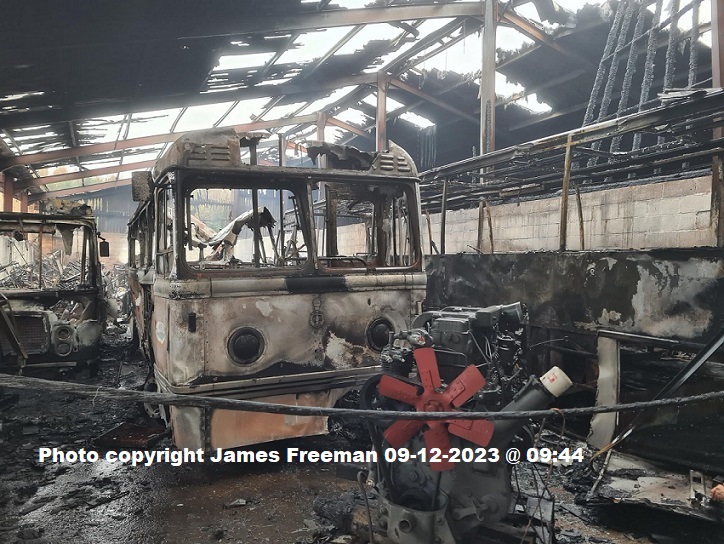
This sad photo, courtesy of James Freeman of FoKAB, shows the remains of the Olympic, still looking recognisable as a bus. On the right of the photo is the remains of B122 XRJ, and on the left the front end of XLJ 726K is all that remains of its bodywork. Beyond these vehicles lie the remains of the other five buses lost, basically just a chassis and seat frames in each case.
Press Release: Monday July 17th 2023: News from Transport Museum, Wythall.
Wythall's annual Bristol Gathering moved from Easter to early July this year to take advantage of longer days and hopefully, warmer weather. Warmer it was, but punctuated by some very heavy thunder showers, none of which affected an enthusiastic gathering. Not seen for several seasons at Wythall were Bristol Lodekka FS 452 XVE (previously 866 NHT), a Bristol convertible open topper and Eastern Counties VG 5541, Bristol G rebuild plus two Royal Blue MW6Gs 56 GUO and 617 DDV, the latter displaying an excellent interior retrim. The Bristol RE was out in force with early United Counties RELH TBD 278G, Eastern Counties RELH GCL 349N (in National Express white livery), ex Thamesdown RESL6G JMW 169P in (yes we know it's wrong) Stroud Valley livery; RELL TDL 564K, the Midland Vectis (ex-Southern Vectis) open topper and TFM 267K, the Crosville RELH, accompanied by Wythall's own Cheltenham District RELL 1000 KHW 306E. Red and White RELH OAX 9F completed the set wearing an attractive BRISTOL RELH 1963/2023 headboard.
Early years of Bristol coaches were represented by handsome Wilts and Dorset 279 (EMW 284), a Bristol L6B from Wilts and Dorset, running on service to the delight of its passengers. The Bristol VRT was also represented by several attendees, Wythall’s latest addition, United Counties VRT 778 (CBD 778K), a 1972 model; the heritage tramway livery Cheltenham District JOU 160P and Bristol (Stroud Valley) VRT EWS 748W. Wythall based MCW bodied West Midlands Travel VRT, NOB 413M and Sheffield OWE 271K with Northern Counties body brought VRT variety and completed the line-up.
Opportunity was taken to pose the Cheltenham District Bristol KSW 90 (UHY 374) alongside the Museum’s RE. Other Ks on site were Bristol Omnibus K5G C3386 (JHT 802) and KSW6B C8322 (UHY 362). Public services were run all day on a variety of routes using a wide selection of visiting vehicles, most in summer sunshine. At the end of the day in a vehicle shuffle preparing for upcoming events, Wythall's Stratford Blue Leyland Tiger PS2 was prepared to enter the paint shop. The added attraction of an excellent display of large scale working Birmingham tram models, commemorating the 70th anniversary of the last original Birmingham tram to run in the city, completed a successful weekend.
Press Release: Monday June 12th 2023: News from Transport Museum, Wythall.
Wolverhampton Guy Arab SUK 3 Restoration Appeal.
Wolverhampton Corporation Transport SUK 3 is a Guy Arab, but an Arab with a difference. Arabs were built at Fallings Park, Wolverhampton, so it was not surprising that the local Corporation chose to buy them. This bus has an early MCW Orion body but as far as its engine is concerned, it's rather different, a wolf in sheep's clothing!
The standard Arab engine was a Gardner in either 5LW 7 litre or 6LW 8.4 litre form. However the bigger units available in the AEC Regent and Leyland Titan PD2 had not gone unnoticed at Guy. So what could they do to provide more oomph? Next door to Guy was the Meadows engine factory while, over the road, was one of the depots of Wolverhampton Corporation Transport (W. C. T.). Constructive talks between the two resulted in the development of the Meadows 6DC, a powerful 10.35 litre engine of compact proportions.
It was something of a surprise when 12 Guy Arabs purchased by Wolverhampton Corporation as late as 1957 not only had the preselector gearboxes it normally specified but also these Meadows engines, derated to 112 bhp – a rare combination indeed.
Its lightweight MCW Orion body was built with a Birmingham-style straight staircase and carried a modified livery, largely overall green with a yellow band as used by WCT on its post 1957 buses.
No 3 was retired in 1972, never carrying W. M. P. T. E. colours. Despite its rare engine it became a playbus with the Social Services department. Luckily, the bus was saved for Wythall in September 1981 but shortage of undercover space meant years of open storage. Winter 2002 saw the bus come inside to be cosmetically restored for display as a static exhibit.
Now is the time for a proper restoration to begin thanks to the kindness of Malcolm Keeley, Wythall member and former Trustee and writer of many books on transport in the West Midlands. Malcolm has kick-started the restoration with a significant contribution. This will not, however, fund the complete restoration so with public help we hope to get this done within a reasonable period.
It requires a lot of structural work to replace the effects of the dreaded tin worm on the body frame, staircase, platform and both floors. Work on the structure has already started at Trailways, appropriately in the Black Country. This work is being done under contract to save time. Mechanical work will also be required as, although it runs, this unique engine requires a full overhaul, which will be completed by the Wythall team.
So if you would like to help bring this unique sounding vehicle back to the road and eventually take a ride, please visit our website for an easy way to make a contribution.
WELSH SOS CHARABANC

Richard Collier sent me this superb picture in September 2022. He said "I wondered if this photograph of my mother was of any interest. At the time she lived in Armley, Leeds, where Ledgards had a depot. She is Muriel Carr, born in September 1914, and was always well dressed."
PSV Circle records helped me discover that CC 7862 was a BMMO SOS QLC with this 29-seat coach/ charabanc body. It was built in May 1928 and supplied to the Llandudno Coaching and Carriage Co. The company operated bus services locally, and also a fleet of charabancs which were marketed using the name Royal Blue Motor Services (sometimes, I think, known as The Royal Blues) - you can just see the word blue in the middle of Royal on the top of the radiator. It was sold to Crosville Motor Services in February 1931 and given the number 585. Clearly that had not happened when the photo was taken, so it seems to date the picture between May 1928 and February 1931, presumably in North Wales.
If anyone has more information about the vehicle, please let me know. Meanwhile, thanks very much to Richard for sending it.
MONICO COACHWAYS
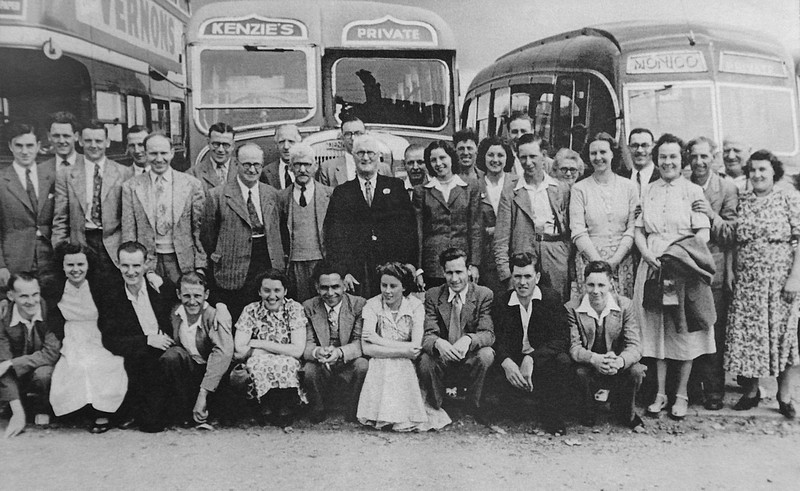
John Wakefield contacted me in August 2022 seeking some details about this photo. The coach in the centre is not the issue - John knows that it shows Kenzies Coaches Dennis Lancet/Yeates C35F ENT 528 carrying an outing from the Greyhound pub in Sawston, Cambridgeshire sometime between 1951 and 1954. Cyril Kenzie (presumably the driver on the day) is second from left on the back row, and Joy his wife in the middle of the front row in a white dress.
The questions are:
John and I thought it could be one of those Commers, but we couldn't find pictures of them. However, in January 2023 the fount of all knowledge John Bennett said he believes the coach on the right is GAA 872, Bedford OB {52500}/Wadham C29F, new to Creamline, Bordon in December 1947 and owned by Monico c1948 to 1952. My thanks to John, as always.
LONDON BUS ROUTES ONE BY ONE - VOLUME 3

Matthew Wharmby was running a fine website about London Buses even before this website existed - and we've been around for over a quarter of a century! So his knowledge of the London bus scene is unsurpassed and it's good to learn that he has now published a third volume of his tour de force, London Bus Routes One by One'. This edition covers the routes 201-300, following on from 1-100 and 101-200.
This volume looks at what used to be London Transport's highest-numbered block of routes, once reserved for single-deck services, but the weight of post-war expansion soon filled in the sequence. A potted history of each route is accompanied by a list of points served and images of buses in service today. With 96 pages and over 190 colour photographs, it represents an up-to-date snapshot of the routes in 2021.
It's priced at £12.79 and can be purchased from Pen and Sword Books.
WHAT HAPPENED TO THIS LOLINE?
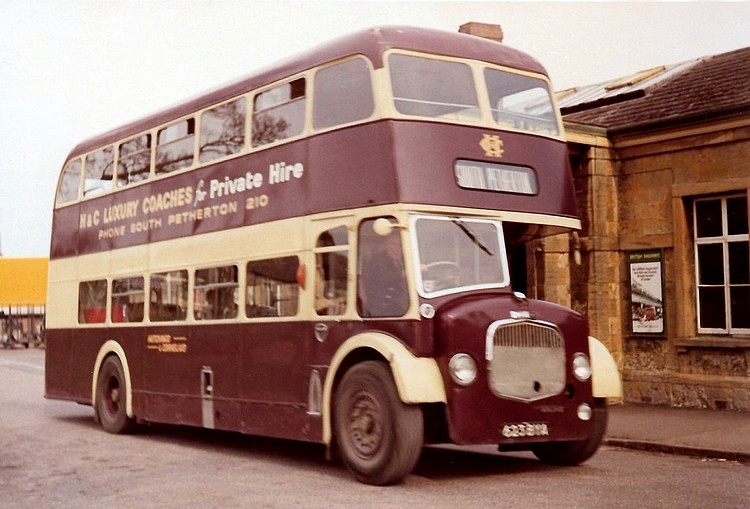
This Dennis Loline (623 BYA) was bought new by Hutchings & Cornelius of South Petherton in 1958 (the only Loline in their fleet) and stayed with them until being withdrawn in July 1973 and sold to Paul Sykes (Transport) Ltd (later rather grandly renamed the Paul Sykes Organisation!), a dealer in Blacker Hill Sidings, Barnsley. Sykes sold the bus in May 1974 to L'Ambrosiana, Milan, Italy. It's not clear what L'Ambrosiana was, but today the name is used by an art museum, a historic library, an estate agent and a cycle club, so take your pick!
In July 2022 Adrian Strong emailed to ask what happened next. What was the bus used for and is it still around? Please email me if you know what became of 623 BYA. Many thanks.
BIRMINGHAM 1931 AEC REGENT IS BACK ON THE ROAD

Newly-restored AEC Regent 486 in Victoria Square, Birmingham.
On 8 July 2022 The Transport Museum at Wythall launched Birmingham AEC Regent No.486 (OV 4486) back on the road after a major restoration that has taken many years. Sold for scrap in 1946 it was discovered in a Herefordshire field in the early 1970s, being occupied by an elderly recluse. It was rescued for preservation but lack of funds or suitable accommodation meant that no serious work began on the bus until 2013.
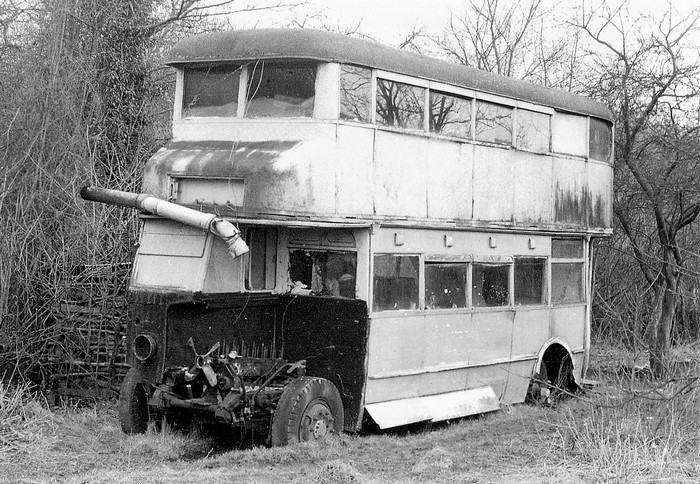
Birmingham 486 as found in a Herefordshire field.
With the aid of various partners and volunteers, thousands of man hours and a cost of around £500,000 (raised from a host of sponsorships, legacies and general donations) the bus arrived back at Wythall in 2018. But then Covid-19 intervened, delaying finishing work on the Metro-Cammell body and engine. Finally the job was completed and this remarkable and historic survivor will, at long last, be able to provide an exciting ride for the public at selected open day Wythall events.
WINGS TOUR BUS
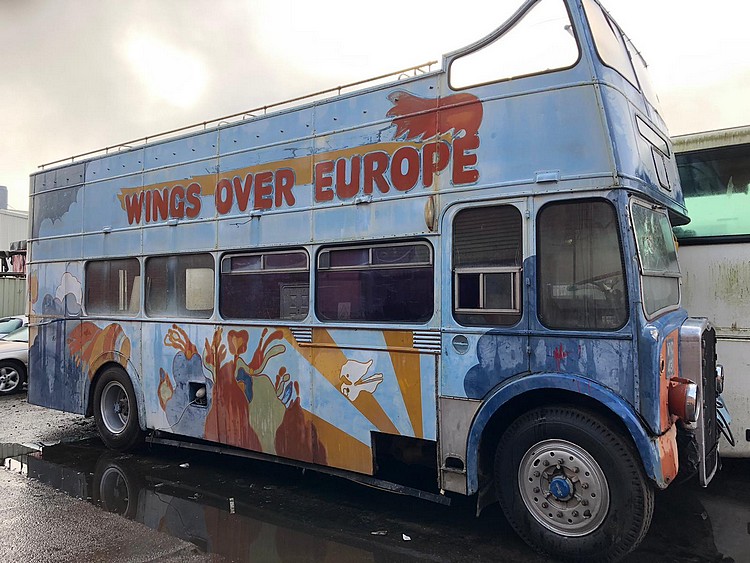
Bristol KSW5G WNO 481 was delivered new to Eastern National as their No.4216 in 1953. In 1966 it was converted to open top and, after a spell with Eastern Counties from 1968, it was retired in 1971 and bought by Hall's Coaches of Hounslow. Halls then converted it for touring and it was used by Paul McCartney's band 'Wings' (and his family) for their first European tour in 1972.
After several subsequent owners it was acquired by Tom Jennings in 2019 with a view to restoring it to its original condition as used by Paul McCartney 50 years ago. The project is progressing well and has the support of Paul, and many other organisations. More information can be found on the website here including details of the bus, the band, the music, news of the restoration and how to support the work. Good luck to Tom and the team!
COOKS WAY

John Hammond has written 'Cooks Way', a book about the Bedfordshire operator Charles Cook Travel. June 2022 marked the 75th anniversary of Charles Cook acquiring his first public service vehicle, a pre-war Dennis Ace previously with the Northern Ireland Road Transport Board. Photographs of the fleet of buses and coaches over half a century are featured in this 88-page book, including many never published before. The book also includes a selection of advertising and publicity materials from the time and is the culmination of 15 years of research into the history of the company.
From June 2022 copies can be obtained for £10 + P and P from www.cooks-way.blogspot.com/ via a secure PayPal checkout. It will also go on sale at Café Mocha, 59 High Street, Biggleswade from 11 June 2022. Charles Cook had his travel office at this address from 1978 to 1995. 30% of the price will be donated to the Bus Archives 'building for the future appeal', helping to equip the new home for this fascinating collection of transport-related materials.
MIDLAND RED D7 NEEDS HELP
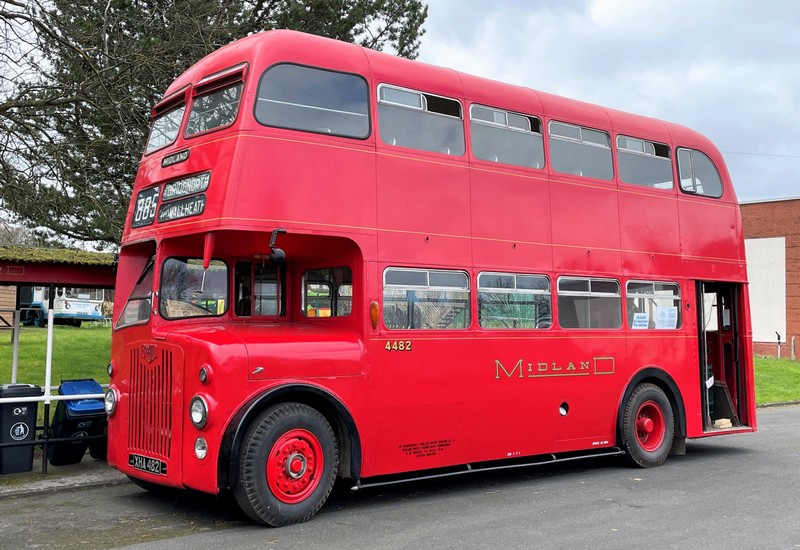
Transport Museum Wythall is taking on a new challenge, the restoration of Midland Red D7 double decker number 4482, the only existing D7 with a viable restoration opportunity. The 350 D7s could be found throughout Midland Red's large territory and were very much work-horses, especially in the Black Country.
Having received a cosmetic restoration for 'Midland Red 100' it has been on display in the museum looking ready for the road, but hiding under the skin are significant structural issues, beyond current museum resources and so preventing its return to regular use on free bus services. The plan is in place for a full restoration to running condition, offering public rides from Wythall, joining their recently restored LD8 and other icons from the Midland Red fleet. This appeal for funding will speed up the restoration programme, enabling this interesting Birmingham-built vehicle to delight enthusiasts and families alike.
Contributions can be made via the Transport Museum Wythall website - just go to www.wythall.org.uk/d7.The names of all those contributing over £100 will be carried on a commemorative plaque inside the bus, and those contributing £500 or more will be allocated a special seat on its first public appearance run – hopefully with a celebrity in attendance. The Museum estimates that around £75,000 will complete the restoration, most of which will be spent on the body structure, which will require a complete strip-down. Fortunately the rest of vehicle is in good mechanical condition.
Only a handful of D7s survived into preservation, most having now fallen by the wayside and XHA 482 is now the only one capable of economic restoration. If the work is delayed much longer, many of the generation who grew up with D7s will not be around to enjoy riding on one in service again. (March 2022)
LONDON TD89 RESTORATION - UPDATE!
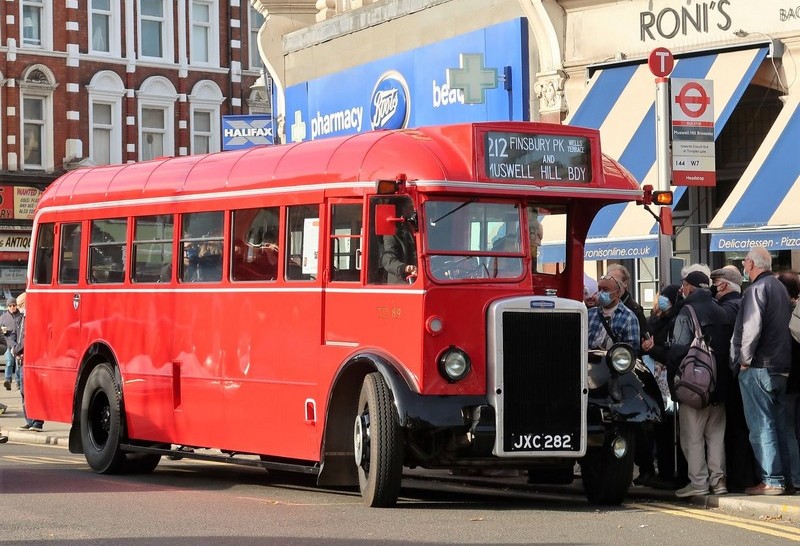
Regular visitors to this website will know that its founder was a great fan of the single deck halfcab bus and, being a softy southerner, the London Transport T (AEC Regal) and TD (Leyland Tiger) are high on his list, because he remembered seeing them in service. So when Nick Street sent this photo of London Transport Leyland PS1 Tiger TD89 (JXC 282) out and about during the Muswell Hill Vintage Bus Running Day on 7 November 2021 after 18 years of restoration by Timebus of St Albans, he was absolutely delighted. Congratulations to Ewen Pring and his team at Timebus, St Albans for a super restoration job.
This website has been following the story of the restoration for some years, and below is a picture sent by Ewen back in September 2020 when the bus finally got back on the road. Timebus acquired it in 2003, and beavered away to rebuild it, with a view to adding it to their classic hire fleet of RM, RLH and RF vehicles.
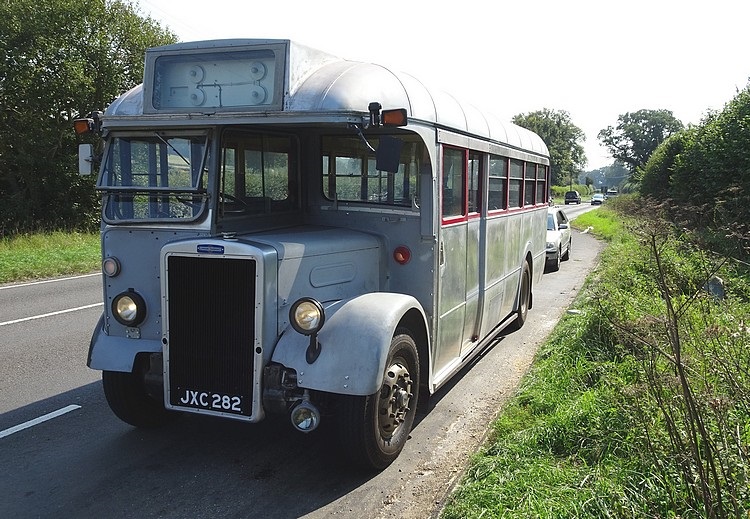 >
>
Most of the wooden framework, between ceiling and floor, had to be carefully replaced. It was a long and very expensive restoration, as the mechanicals and body were all worn out. Ewen said "The mechanicals are still not right (crunching whilst trying to engage gear when stationary - something to do with the 'clutch stop' I believe) and it needs painting, application of vinyls and signs, and the interior is filthy from over a year inside the workshop. The occasion of the photo was taking it away after an engine change. The replacement engine was ex-army (for Leyland Hippos) and must have been overhauled decades ago but not used, because it was found to fill up with oil which overflowed out of the top. This turned out to be because the main gasket between the cylinder block and the crankcase didn't have the 2 vital oilways in the centre, to rain the oil down after circulation!"
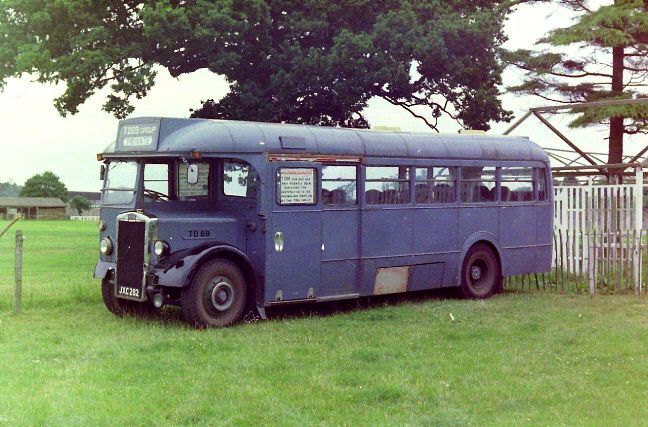
Shown above is a picture from 2008 of work in progress, which just goes to show how much effort Timebus put into the restoration.
Since the only TD we have seen for many years is Cobham's TD95 (beautiful as that may be!), TD89 is a fabulous addition to the preservation scene. Dick Gilbert last saw it working out of Edgware in 1962 (its last year of service), and didn't expect that it would last another 60 years! My thanks to Ewen and Nick for the pictures and information.
By the way, if you want to read more about the history of TD89, download this amazing tale from 1966.
EDWARD JONES AND HIS EAST KENT CAREER
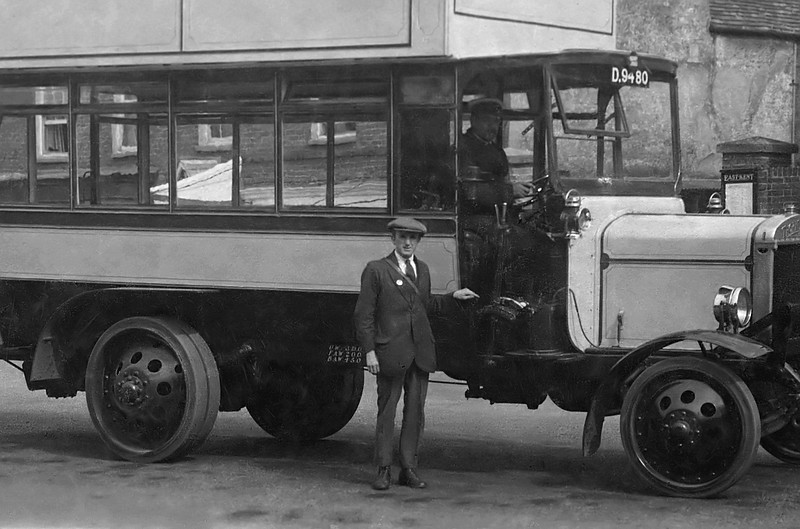
We have previously told the story of a long-serving East Kent conductor and driver (see Chick Perkins on Page 2), and David Richardson kindly contacted me in May 2021 with another. This time the subject was Edward Percy Jones, born in Canterbury in 1884. Edward was a tram conductor aged 26 by 1911, probably working for Isle of Thanet Electric Tramways which operated between Margate and Ramsgate. After serving in the military during the First World War, he later joined East Kent Road Car Co as a conductor, and is shown in the picture above standing in front of one their Thornycroft J buses (registered D 9480). Solid tyres indicate that the date would probably be around 1920.
By the 1930s Edward (and his wife Florence) were living in Margate, by which time he had become a driver. The picture below shows him (on the left) with East Kent Leyland TD1 Titan JG 651, one of five delivered in 1930. Being too old for military service in the Second World War, Edward remained as a driver with East Kent.
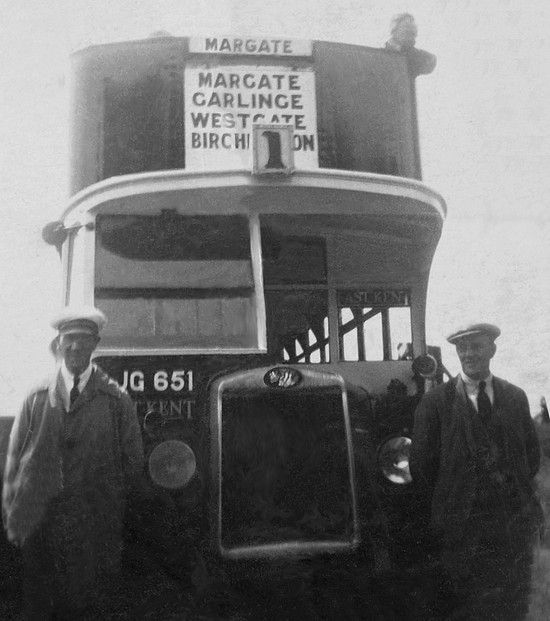
The Royal Society for the Prevention of Accidents issued Edward a silver medal for five years' safe driving, with a bar for each year between 1943 and 1947. He retired in 1949, but sadly died only three years later in October 1952. Thanks to David for sending the story and the interesting pictures.
FINAL DAYS OF A SOUTHEND REGAL
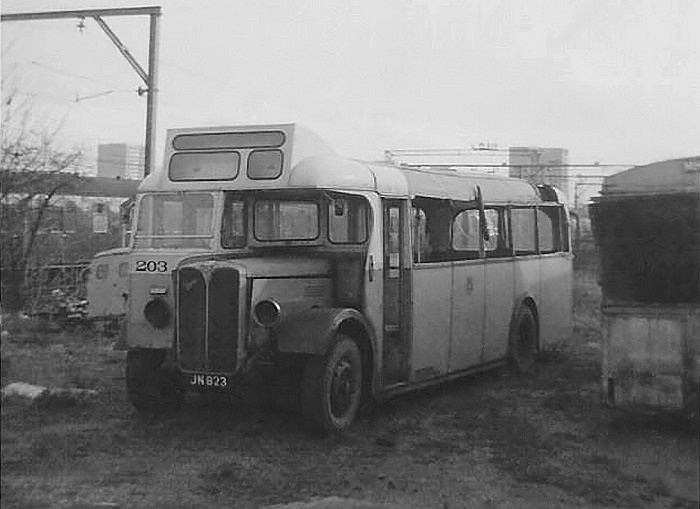
In December 2020 Ian Banks sent this atmospheric photo. He said "I took it in 1966 at the then Corporation works in Southend. The bus had been withdrawn. I never drove this one as I joined in 1966." The picture shows Southend No.153 (JN 823, chassis number 662872), one of a batch of seven built originally with stately English Electric 30-seat dual-entrance bodies. They were all delivered in March 1931 but didn't enter service until July 1932. It received a Gardner 5LW engine around 1938, and was renumbered to 203. In 1955 the bus was one of two rebuilt by Southend Corporation to DP35F (using second-hand London Transport seats) as seen here. It was withdrawn from passenger service in 1962 as the last Regal in the fleet and became a driver trainer. In 1965 it was transferred to the Highways & Works Department, but they don't seem to have used it, and the bus was sold for scrap in 1968. Many thanks to Ian for the photo.
BURNLEY PAIR REUNITED
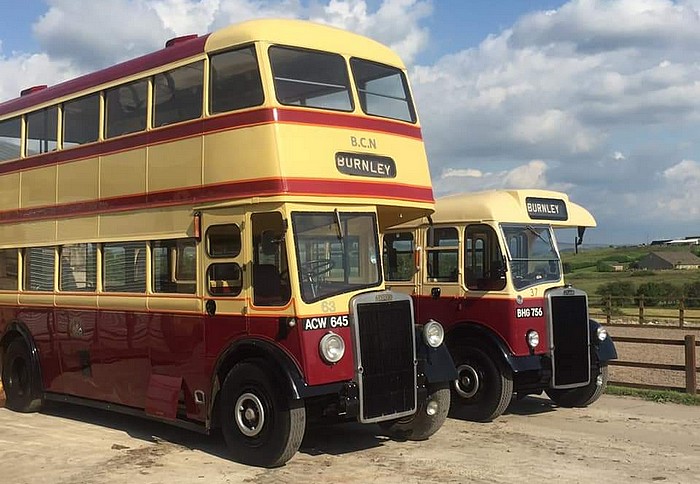
Michael Banham-Guerrero is the proud owner of former Burnley, Colne and Nelson No.37 (BHG 756), a 1953 Leyland PS2/14 Tiger which he acquired in 2018 from Paul Kirkup, who had owned it for many years. It was withdrawn from service in 1974 and was preserved at the Bury Transport Museum for a while before heading to Essex where Ron Benstead started a programme of restoration. In 2020 the bus moved to a new home in Padiham, Lancashire which it shares with another former Burnley, Colne and Nelson bus, No.63 (ACW 645). This is a 1950 all-Leyland PD2/1 Titan which was renumbered to 153 in 1962 and sold in 1971, although it did actually return to the fleet in 1977 as a driver trainer (by which time the company had become Burnley and Pendle Joint Transport Committee). Acquired for preservation, it moved home several times before undergoing an extensive restoration, and over recent years has been seen frequently on the rally circuit. I believe that fourteen former Burnley, Colne and Nelson buses survive (unless you know better!), which is remarkable for a relatively small fleet. Many thanks to Michael for the photo.
SOUTHDOWN HISTORIC VEHICLES ENJOYING THE SUNSHINE

Daniel Pearce sent me this splendid photo in October 2010 of some of the Chris Pearce collection, Southdown Historic Vehicles. Daniel said "Myself and Richard Alexander have taken over maintenance of Dad's fleet over the last three years. Here is a photo I thought you might like, taken when we had a move around a little while ago." From right to left we have: Southport PD2 GFY 406, Portsmouth PD2 GTP 995, Wigan PD2 DEK 3D, Salford PD2 JRJ 281E, Southdown PD3 BUF 260C, and four other Southdown PD3s. This is only about half of the entire fleet! My thanks to Daniel for the information and the photo.
THE PHOTOGRAPHER PHOTOGRAPHED

Andy Hawthorn took this sneaky picture of Roger Burdett proudly taking a snap of two glorious coaches at his premises before heading off to The Transport Museum at Wythall on Sunday 4 October 2020. The vehicles are the 1950 former Gillett & Baker AEC Regal III LPT 328 (which had just been acquired by Trevor Cockings of the His Church charity in Lincolnshire) and his recently-acquired 1948 Southdown PS1 Tiger HUF 303 - what a beauty that is! Many thanks to Andy for the picture.
PULHAM BEDFORD RESTORED
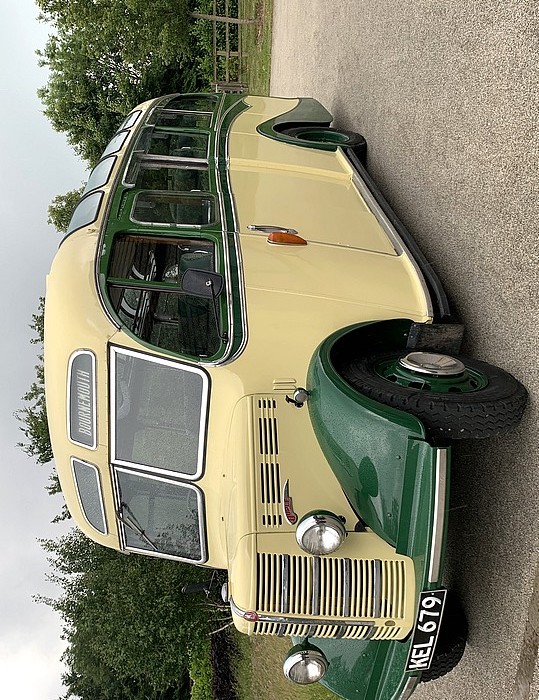
Back in 2017 I had a discussion with Kathryn Pulham of Pulham & Sons Coaches Ltd, Bourton-on-the- Water, Gloucestershire regarding the paint colours to be used on their Bedford OB coach KEL 679 which was being restored to its original Hants and Dorset livery. I wasn't much help, but the work progressed anyway and then, three years later, the job was nearly done! New in 1950 as Hants and Dorset No.687 with its typical Duple Vista body, it spent a few years with Classic Coaches in Jersey from the mid-1990s as J 5149, returning around 2002 and being acquired by the Pulham family shortly afterwards.
It obviously went away to be worked on, because Kathryn sent me these pictures in June 2020 and said "We have signwriting to complete and a few bits and bobs but she's home!" It looks terrific, and so does the interior. Thanks to Kathryn and, one day when this virus nonsense is all behind us, we'll be able to see this glorious piece of history back on our roads again. Pulham's website is here.
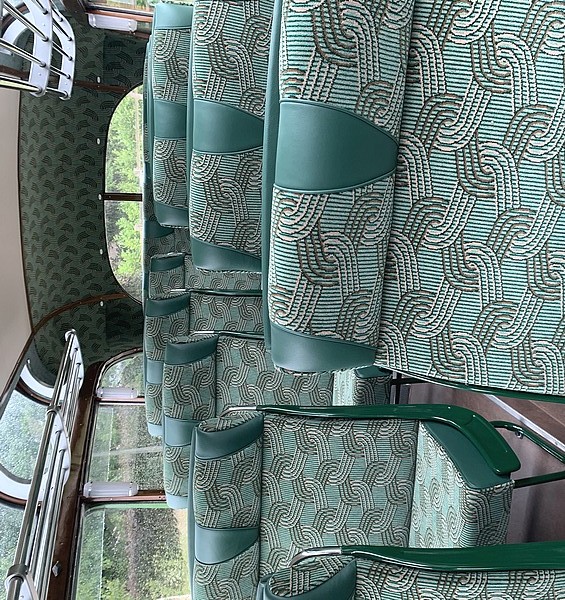
NEW BOOK ABOUT THAMES VALLEY

Paul Lacey has a new book out soon. "Thames Valley - A Centenary Album" celebrates in pictures 100 years since the formation of Thames Valley Traction and its subsidiaries Newbury & District and South Midland. The book's 144 A4 pages contain 330 monochrome photos and 100 in colour, previously unpublished and each with a fully-detailed caption.
Send a £23 cheque for this post-free offer to Paul Lacey, 17 Sparrow Close, Woosehill, Wokingham, Berkshire RG41 3HT or phone 0118-979-4097 to arrange collection of the book personally. Paul also has special offers on his other titles covering Newbury, Reading, Henley, Marlow and the surrounding area.
NEWTON & WARD FROM WAKEFIELD
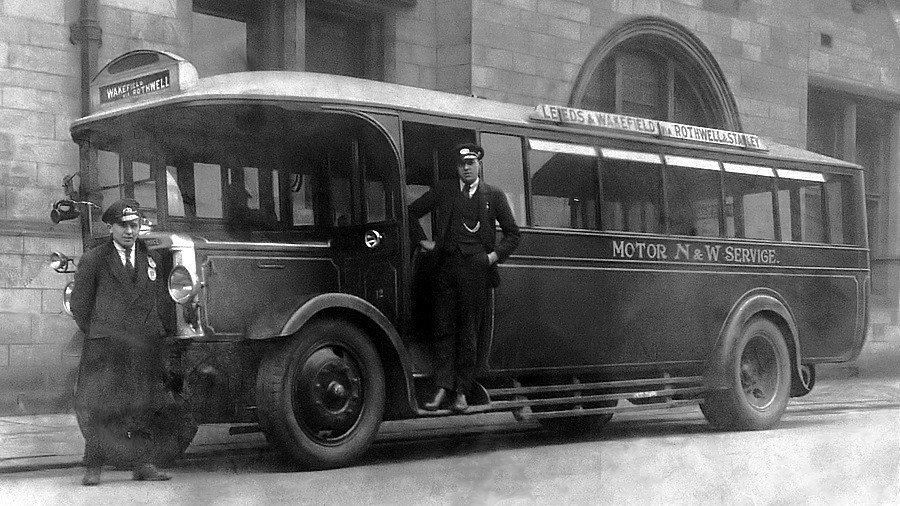
Michael Wright sent me this picture in April 2019 to ask if I could throw any light on the bus and the operator. His Grandad (Ernest Ward, on the right with the cleanest boots!) worked for the firm but that's about all Michael knows, apart from still having his driver's badge ("City of Wakefield No.948"), although it's the chap on the left who seems to be the driver in this picture.
Well, the route - Leeds to Wakefield on an easterly diversion through Rothwell and Stanley - later became West Riding route 92. It must have been in demand because West Riding were running it every 20 minutes by the 1950s! But what sort of bus is it, and who were N and W Motor Service? Perhaps they were absorbed into West Riding eventually.
Peter Delaney offered the following information:
"N and W would be Newton and Ward Ltd, a company formed in August 1928 to 'acquire and carry on the motor omnibus business hereto before carried on at Rothwell, Yorkshire, by Messrs Newton and Ward in partnership', and had its registered office at Oulton Lane Garage in Rothwell (although neither Mr Newton nor Mr Ward were directors of the company). Leeds City Council noted in December 1925 that several firms from outside the city had agreed to conditions to be included on their licences, and amongst those firms was Newton & Ward, who were running from Lee Moor into Leeds. Six months later in June 1926 the Leeds Watch Committee approved a proposal for Newton & Ward to acquire the motor omnibus service between Leeds and Swillington previously run by Burks Brothers. The firm was also listed in the March 1928 issue of Commercial Motor magazine as having bought some (unspecified) Leylands".
"At a meeting on 31 August 1932 the company was formally put into voluntary liquidation, with the winding-up meeting held in Leeds on 29 November that year. The location of the first meeting at Belle Isle, Wakefield may be relevant? The directors of Newton & Ward Ltd were H England, G H Margrave, A Corker, R Harkey, A Carrington and J Stonehouse. H England was the first General Manager of West Riding, and he was succeeded by G H Margrave with H England becoming Managing Director. It looks as if there was a connection with West Riding, although whether this was a formal one (such as West Riding buying Newton and Ward) I have not been able to find out. I wonder if the Ernest Ward in the picture is related to the Ward of Newton and Ward?"
Well that's a good question at the end there, and it also makes you wonder if the other chap is Mr Newton! Michael Wright then asked his Mum (who is Ernest Ward's daughter) about it, but unfortunately she said that his Grandad was not related to the owners of N and W services. Anyway thanks very much to Peter for his comprehensive response, and any further information would be most welcome.
John Bennett recognised the type of bus. He said "The bus in the picture is an ADC. I've tried
to read the reg number in the back window, but cannot get the image sharp enough. It is either:
Newton and Ward also had three Leyland Lion PLSC and a Maudslay ML3B when they sold out to West Riding in September 1932."
Many thanks John. But then I received an email from John McSparron who directed me to this page. Clearly taken around the same time, but not at the same location (the caption says it is outside the tram sheds in Swinegate), the crew have moved about a bit and the registration WW 5359 is revealed. Problem solved, I'd say. Thanks a lot John.
In May 2021 I received an email from Mike Bennett (no relation to John Bennett!) who corrected my previous typo error in the registration - thanks for that. He also said that the location of the photo at the top of this item is "...on Burton Street, Wakefield, to the rear of the former West Riding County Council's County Hall - see 3 Burton Street on Google Maps. I note also what appears to be a number '12' painted on the bulkhead behind the nearside front wheel. If so, that is new information - it's surprising what you can glean from old photographs!" It certainly is, and thanks very much to Mike for letting me know.
SUNDERLAND IN THE SNOW
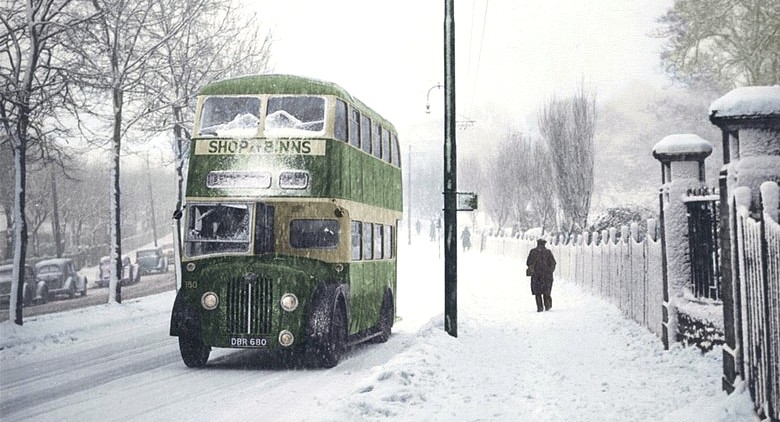
Here is something a bit different for this website - a picture that has been artistically coloured, in this case by Malcolm Fraser. This is Sunderland Corporation No.180 (DBR 680), a Guy Arab with a Crossley body, when brand new in early 1954 seen in Ryhope Road looking south. The bus stop is outside the gates into Backhouse Park. It was a tram stop until November 1952 and the poles are still in place carrying the street lights.
Although the origin of the photo is not known, the colour was added by Malcolm and this is just one example of his art. Much more of his work can be found in his Flickr collection here where you will find dozens of buses, trams, horse buses, trolleybuses and trains brought back to life with the miracle of colour. I love it all and many thanks to Malcolm for letting me use this image.
HEAR THE MIGHTY TIGER ROAR!
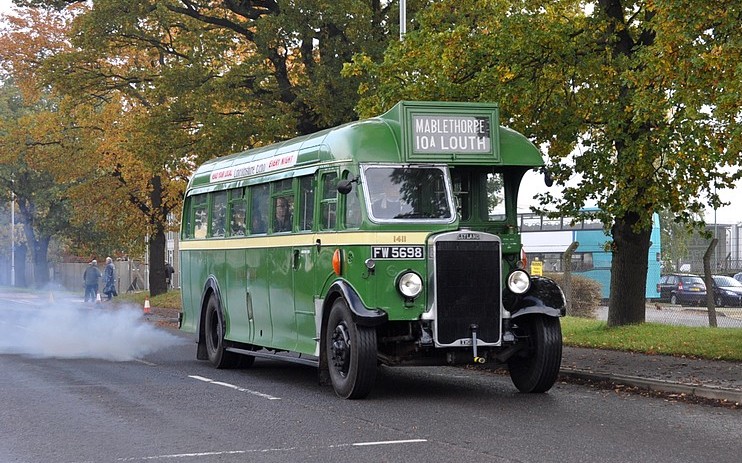
Ken Jones took this picture on 3 November 2019 at the Lincolnshire Road Transport Museum's Transport Festival. Resident Lincolnshire Road Car Leyland TS7 Tiger 1411 (FW 5698), which dates back to 1935 but has a post- war Burlingham body, is seen in full steam at one of the last events of the 2019 rally season and marked the winding down of a very busy summer. Many thanks to Ken.
BELFAST GUY ARAB COMPLETES RESTORATION
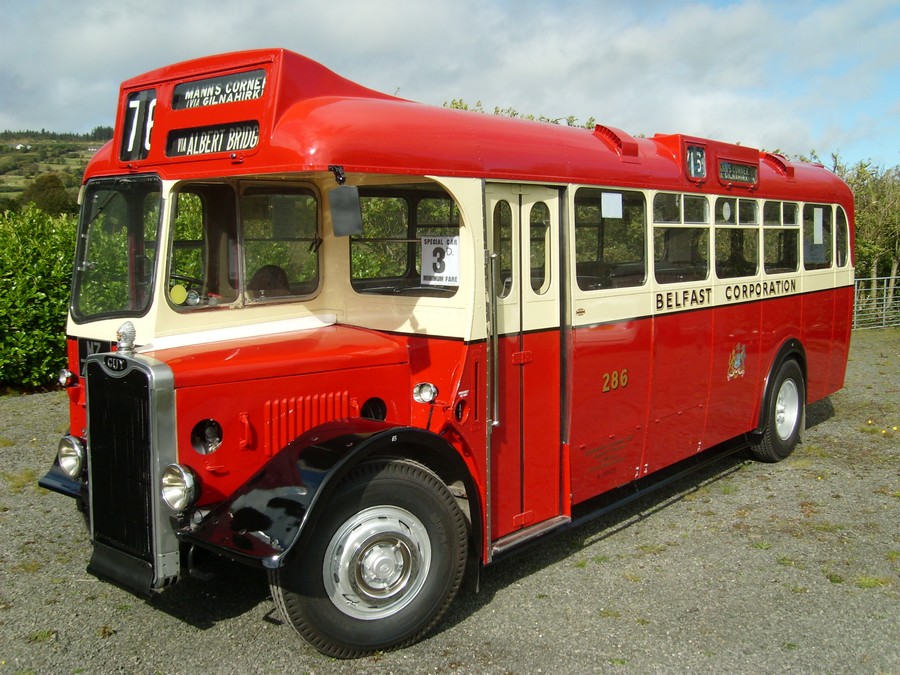
Jonathan Miller kindly sent this fine view of his glorious Belfast Corporation Guy Arab III No. 286 (MZ 7384) which has recently emerged from a seven-year restoration. One of a batch of 25 delivered in 1950 (along with 45 double deckers) with fleet numbers 280 to 304, its body was made by local coachbuilder Harkness who had a fine reputation for quality workmanship. The bus wears its original colour scheme but was later repainted in a predominently cream livery (with a cream roof) for special duties, private hire and city tours.
Jonathan said "When converted for special events in 1960, this work was actually initially undertaken to create a committee coach for the Councillors of Belfast Corporation. It had the side and rear destination boxes removed at that time. Reinstating the destination boxes, plus fitting a new roof, were just some of the jobs I completed over the seven years. I do all my own work except paint - I leave that to the experts!"
"It was hijacked and used as a street barricade during riots in Belfast around 1970. I have photos of it pulled across a street with the tyres deflated. It was recovered and repaired. Unfortunately shortly after this event it was extensively damaged by fire when the yard in which it was stored was petrol-bombed. This destroyed much of the nearside of the vehicle. It was poorly repaired, using plastic panels and plastic windows and served the Belfast Corporation Anglers Club for a couple of years, before being sold into preservation, although only dry stored. It wasn't until 1985 that worked started on its restoration. I actually helped the original owner restore it between 1985 and 1986 so I've now been associated with it for 34 years!"
Similar No.298 survives with the National Transport Museum of Ireland at Howth and the body of No. 304 was used for many years as a painting studio in Co.Limerick but was acquired by another owner a few years ago. Anyway many thanks to Jonathan for the photo and the information, I'm sure you will agree that it looks terrific.
THE LIFE OF A COMMER COMMANDO
Chris Stanley has inspired me to write another item about one and half decker Commer Commandos by sending a couple of pictures (the bottom two below).
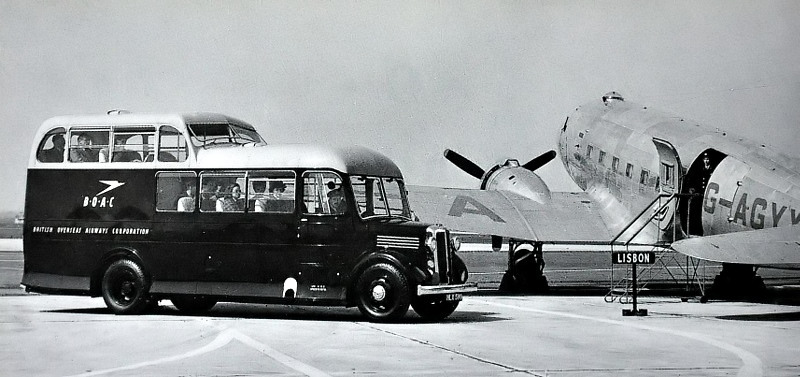
Let's start with a bit of background. Commer built about 300 of these little buses between 1946 and 1948 on a UK government contract to provide transport for the state airlines BOAC and BEA, the RAF, and the Ministry of Supply who dispatched some to factories and other sites. The picture above shows one of the BOAC buses, probably at Northolt, appearing to deliver passengers to a Dakota aircraft bound for Lisbon. I suspect that this may have been a "staged" publicity photo. For one thing, BOAC were a long-haul airline and didn't operate flights to Lisbon, and also I think this bus is HLX 599, the second of these Commandos to be built and the first one delivered to BOAC (in March 1946), so that may be what this is all about. By the way, the "upper" deck was not there to provide a better view - it was mounted over the top of a large boot to accommodate passengers' baggage.
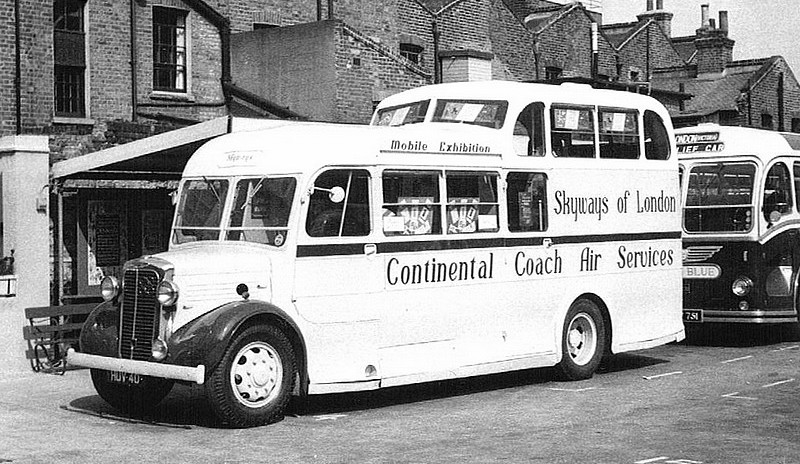
The coaches had Park Royal bodies seating 20, which was pretty much a full plane-load at the time, but newer aircraft were larger, so 20 seats wasn't enough and the buses often wound up carrying crews rather than passengers. But by the mid-1950s they were outdated and started to be sold off, and this picture shows another BOAC coach (HUV 40 dating from June 1946) after sale to Skyways who were using it to promote their new coach-air service which ran East Kent AEC Reliances from Victoria Coach Station (where this photo was taken in the late 1950s) down to Lympne Airport in Kent where a Skyways Dakota would fly the passengers to France. By coincidence one of the Dakotas that Skyways used for a while was none other than G-AGYX - the same one as shown in the previous picture.
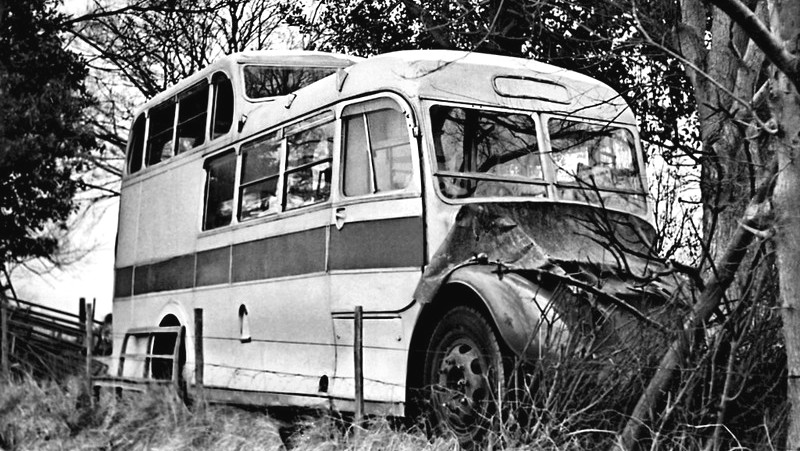
By the early 1960s Skyways had finished with HUV 40 and its fate was unknown to me, until Chris Stanley very kindly sent these two pictures which he acquired from someone who, in turn, got them from a deceased friend. It's clearly the same coach and is apparently rotting away in a field in Sellinge, which is within spitting distance of Lympne Airport, so that makes sense. I was a Skyways employee at Lympne 1965-69 but never knew that the coach existed nearby. By the look of the paintwork it has clearly had another owner since Skyways days - perhaps as a mobile home - and someone has removed the engine. It was originally a 6-cylinder 4-litre petrol engine, but I notice that the picture at Victoria Coach Station shows it with a Perkins diesel badge on the radiator grille. However it doesn't look to be in a bad condition overall.
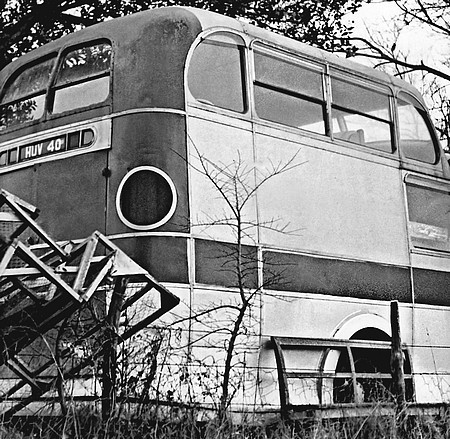
It's sad to see this example in its terminal state, but there are still a few survivors, one of which (a former RAF bus) can be found about half-way down Page 3 of this series. I just love these Commer Commandos and intend to create a page or two about them one day, when I have the time! In the meantime I must thank Chris for sending his pictures and setting me off on this interesting trail. Footnote; Oxford Diecast made models of HXF 339 in BOAC livery and HUV 40 in Skyways livery.
A BRUM REUNION

A great event took place on 28 April 2019 when three Birmingham City Transport Leyland PS2 Tigers were seen together, almost certainly for the first time in 50 years. Lined up at the Aston Manor Road Transport Museum are No. 2245 (JOJ 245) of The Transport Museum, Wythall, freshly-restored No.2257 (JOJ 257) from Quantock Heritage, and Tim Bickley's No.2231 (JOJ 231). No.2255 is reputed to exist as well - maybe we'll see that one day too. For more details about these fine buses take a look at my webpage here.
Accompanying them on left is former Birmingham AEC Matador breakdown tender 217 GOE which started life as a command vehicle for the Army during World War II. A great photo by kind permission of Ken Jones.
A FODEN DUO
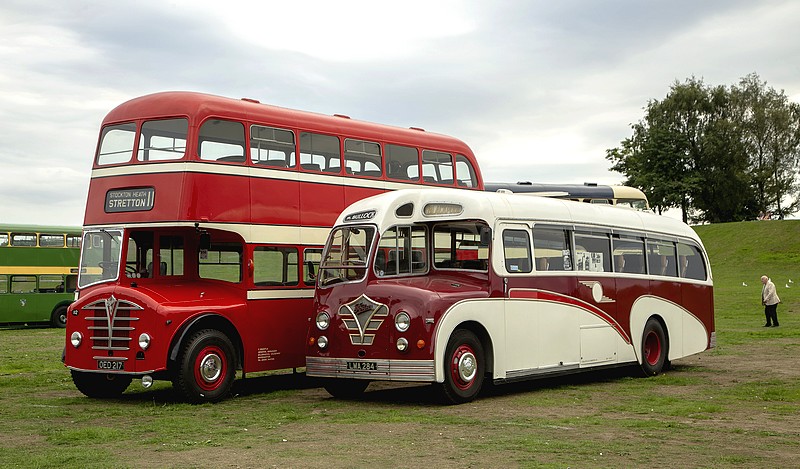
Paul Williams sent me this fine picture which he took at the Trans Lancs Transport Show in Manchester on 2 September 2018. He asked "How often do you find two halfcab Fodens together? It is quite interesting to note that the single decker has been in the ownership of Bullock's of Cheadle (Cheshire) for over sixty years. Normally it's on loan to the Manchester Museum of Transport."
For the record the double decker is OED 217, a Foden PVD6 with an East Lancs body, new as Warrington No.112 in 1956 (one of a batch of five) and currently the property of an owner in its home town, although it usually lives at the North West Museum of Road Transport in St Helens (thanks to Mike Lloyd for that information). In fact I believe this was the last production Foden bus to be built.
The coach is LMA 284, a Foden PVSC6 delivered new to Coppenhall of Sandbach in 1949 with a Wadham coach body but rebodied by Lawton around 1958 with a style of bonnet designed by Coppenhall themselves. Many thanks to Paul for the unusual picture.
VINTAGE VIEWS FROM WISBECH
John Wakefield kindly sent me these delightful old pictures of street scenes from Wisbech, Cambridgeshire taken by local professional photographer Mrs Lilian Ream who had several studios in the town. They are part of her collection held by Cambridgeshire County Council Library Service and published in a book "Lilian Ream - a life in photography".
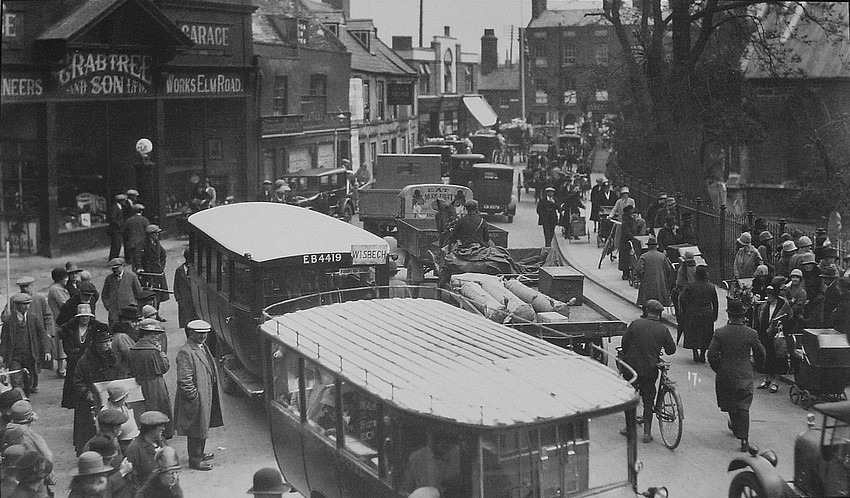
The above picture shows Church Terrace in 1928. The bus with registration number EB 4419 is a Ford model T 14-seater new in October 1923 to Washington, Littleport and then to Farrow, Wisbech in December 1927. The unidentified bus in the foreground also looks like a Ford T - probably also operated by Farrow.
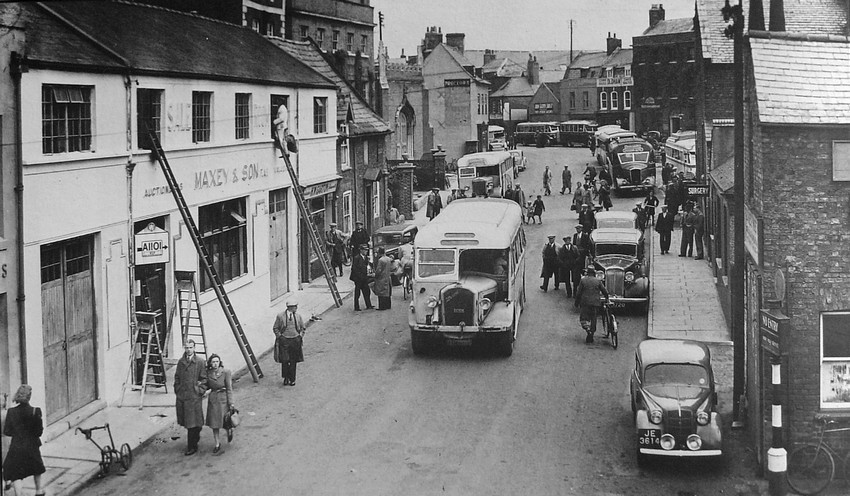
The second picture was taken in Chapel Road in 1946 or 47 and certainly shows a lot of buses and coaches! Probably it was taken on a market day - the market is at upper right of the picture. An anonymous source has suggested that the vehicles may be as follows:
Left, front to back:
Centre, front to back:
Right:
None of that information is certain, but it's likely. By the way L Coleman and Son (operator of one of the Regals) only ran into Wisbech on Thursdays and Saturdays, so the picture has to be taken on one of those days. Many thanks to my "anonymous source" for the additional information, to John for sending the pictures, and how wonderful of Lilian Ream for taking such atmospheric shots.
ALEXANDER REGAL IS BACK ON THE ROAD
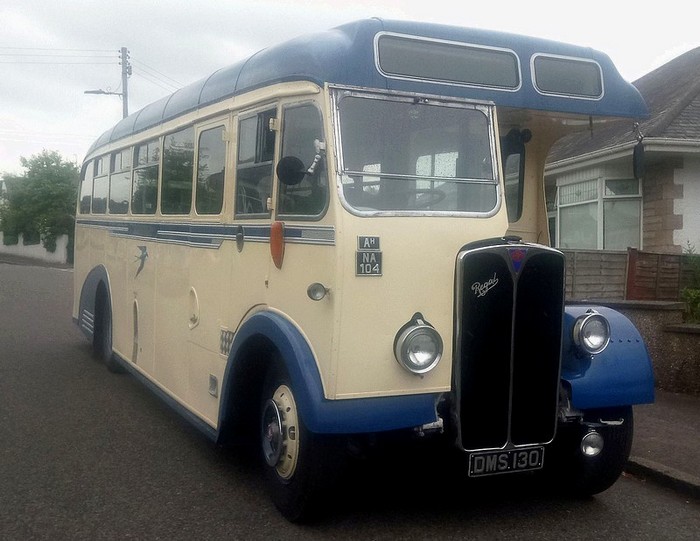
Gareth Ware took this picture in August 2018 of his newly-restored 1951 Alexander AEC Regal NA104 (DMS 130) which he has taken over from John Braga. Formerly in yellow Alexander (Northern) livery it now wears Bluebird colours and is to be based at the Glasgow Vintage Vehicle Trust museum. It is the only survivor of Alexander's last batch of Regals which were of the 682 variety with the smaller 7.7 litre engine and (in this case) an 8ft wide body on a 7ft 6in wide chassis (note the visible overhang at the wheelarches). Thanks very much to John Braga for forwarding the photo and congratulations to Gareth!
OLDEST ROADWORTHY BRISTOL RECOVERED FROM USA
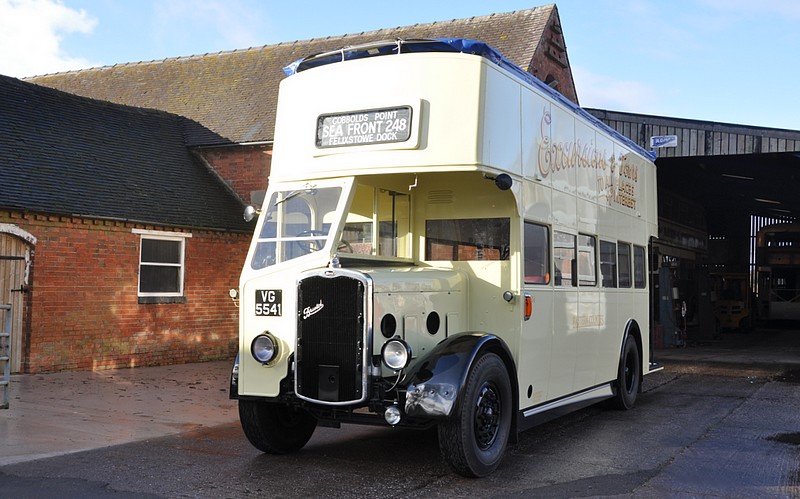
In April 2018 Ken Jones sent me this picture that he took in Staffordshire earlier in the year. It shows former Eastern Counties Bristol GJW open topper HLG4 (VG 5541). The fact that it was built in 1933 makes it the only surviving Bristol G currently on the road, the oldest roadworthy Bristol, and the oldest roadworthy seaside open top bus conversion! Thanks to Ken for those facts.
Built as a highbridge double decker for Norwich Electric Tramways (the 13th Bristol G to be built) it quickly passed to Eastern Counties, who converted it to open top in 1950. Retired in 1960 it was exported to California in 1962 and painted red. Tipped off about its availability (free, but buyer must collect it!) by the British Bus Preservation Group, Roger Burdett nobly acquired it in 2000, not without many trials and tribulations en route.
Ken wrote "It is now back on the road again after extensive and expensive restoration, including hand-painted advertising in gold leaf copied from black and white images - different each side." Many thanks Ken, and congratulations to Roger. It's a gem.
TWO WONDERFUL OLD PICTURES FROM BOURNEMOUTH
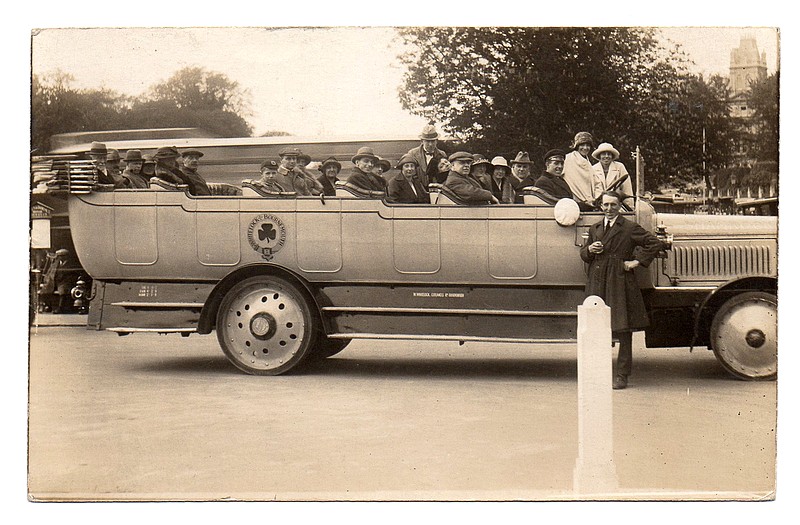
In February 2018 David Winter very kindly sent me these two glorious images from Bournemouth, acquired from his grandparents. The one above shows a vehicle owned by W. Whitelock, Cotlands Road, Bournemouth. William J. Whitelock formed a horse bus company named Shamrock (hence the shamrock leaf in the crest) in the town in 1885, moving up to motor buses in 1913. He merged his company with competitor Bournemouth Rambler in 1924 to form the well-known coaching company Shamrock & Rambler which lasted until 1989. This picture pre-dates pneumatic tyres so is probably from the early 1920s.
Shamrock Coaches acquired EL 4534, a Leyland "O" with a 28-seat charabanc body by Bartle in May 1920, and EL 6136, a Leyland 40hp 28-seat charabanc in February 1921. I believe that this is the former.
.jpg)
The second picture (which may have been taken as much as 5 years later than the previous one) show an all weather coach belonging to S and S, Enterprise Motor Coaches, Bournemouth apparently visiting Cheddar Gorge. S and S stood for Symes and Sons. Enterprise had a small booking office in Commercial Road between Lyons Teashop and Burton Tailoring but their main depot was in Terrace Road, Edmondsham.
By 1930 they were operating Dennis and McCurd vehicles and this view shows No.15 in their fleet. McCurd Motors of Slough was the last in a series of motor manufacturing companies set up by Wallace A. McCurd, but their vehicles were not common. Enterprise bought four McCurd coaches in 1928 with 26-seat bodies by Duple (RU 7675, 7858, 7859 and 7860). RU 7858 was No.11 in the fleet, so this has to be one of the other three. Enterprise ceased trading around 1939.
At first I assumed that the inscription "Visiting Gough's Cave Cheddar" under the coach was an addition stuck to the photo after the event but I now understand that there were a number of photos taken at this exact location. A local photographer must have had quite a good little business going, but would have needed to move fast to get the processing and printing done while the passengers visited the caves, which I presume is how it was done. So that board really existed!
Many thanks to David for sending the pictures.
WEST BROM BUSES AT THE BLACK COUNTRY LIVING MUSEUM
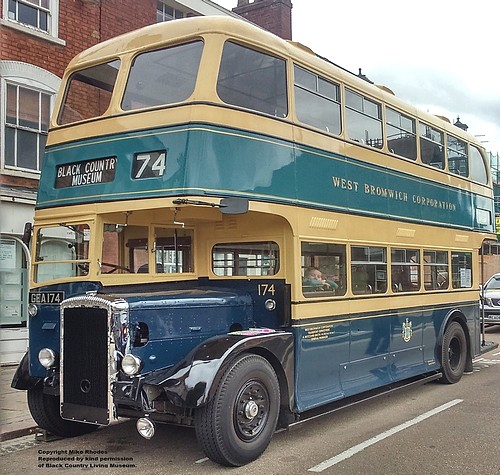
Mike Rhodes of the Black Country Museum Transport Group kindly sent me this picture of West Bromwich Corporation Daimler CVG6 No.174 (GEA 174). It was new in 1952 with a Weymann 56-seat body and ran in service until the early 1970s when it was given to Dudley Libraries by WMPTE for the then fledging Black Country Museum. The bus was in store for many years but then had a complete rebuild over nine years. Since 2013 it has been regularly taken to shows and is on display at the Black Country Living Museum where it is the flagship of the vehicle fleet. Mike took the picture in Dudley in 2015.
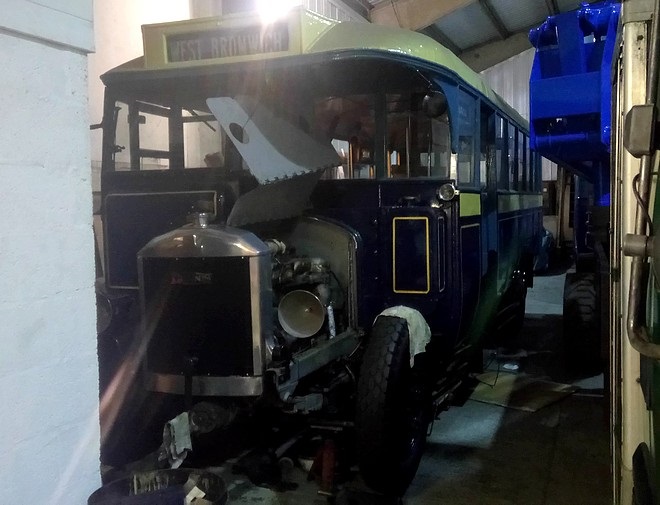
Mike also told me that West Bromwich No.32 (EA 4181), a Dennis ES bus dating from the end of 1929 is at the Museum and nearing the end of restoration as a runner. Recent pictures of this bus are rare, but here's one he took showing it tucked up in the depot for the winter along with three trolleybuses, a Guy Vixen coach, a Guy GS bus, a BMMO D9 bus and two cherry pickers!
Mike says "As you can see it has been completely repainted on the outside. Inside it has had various woodwork replaced and the seats are currently being stripped and redone. The engine goes and stops although setting it correctly is proving troublesome. It has been driven round the site under its own steam and the volunteers working on it are really looking forward to it being completed and used. It will nicely complement the Museum's West Bromwich Corporation Daimler and Guy GS."
Thanks to Mike for the pictures, and I hope he'll keep us updated about the Dennis.
LANCASHIRE TIGER FINDS A NEW HOME
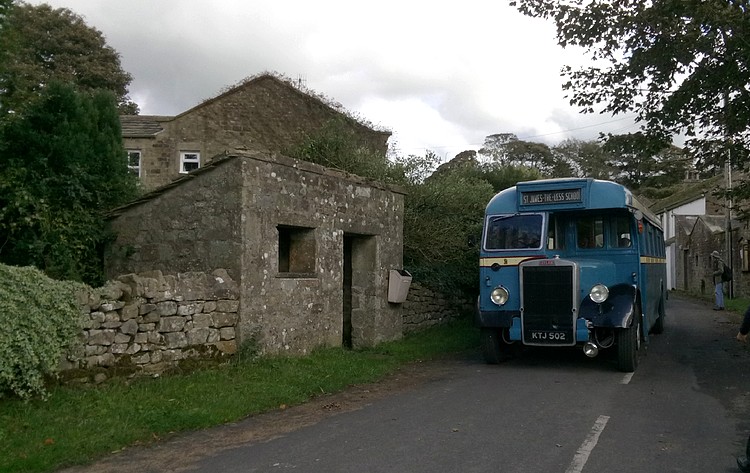
Rachel Fielding from Blackburn emailed in October 2017 to say that she and Paul Fielding have purchased KTJ 502, an ex Haslingden Leyland Tiger PS1 with a Burlingham body and are enjoying her to the full. Here's a picture to prove it. Thanks Rachel.
REGALS GATHER AT DAWN

How about this for a wonderful sight? Four fabulous AEC Regals at Roger Burdett's facility just before departing to the Oxford Bus Museum Vintage Transport Festival on 30 July 2017. They are (left to right) Burnham's 1948 Regal III CFK 340, Eastern Belle 1953 Regal III NXL 847, York Pullman 1954 Regal III JVY 516 and (my favourite) Salisbury/ Standerwick/Ribble 1934 Regal I FV 4548. Thanks very much to Ken Jones for the photo - it made my day!
NEW BOOK ABOUT KENT INDEPENDENTS

David and John Watts have published a history of J. H. W. Watson of Rochester, who traded as Wilberjim Coaches. The book also provides a detailed look at many other independent operators in the north Kent area and is generously illustrated with a large number of fascinating pictures dating back to the earliest days of bus and coach services, many never previously published and some from this website!
Anyone with an interest in the history of buses around Medway will find this a jolly good read. "Who is this Mr Wilberjim" is available at £13.50 including post and packing by emailing John Watts.
GUY VICTORY RETURNS HOME

The Guy Victory in service with its original Jonckheere body
Martin Fisher emailed in June 2017 to tell me about what is believed to be the only Guy Victory in Britain. He said "A couple of years ago I was contacted at the Aldridge Transport Museum by someone from Belgium who told me he owned a 1961 Van Hool bodied Guy Victory which had been used as an office since being withdrawn from service in 1979. I expressed a lot of interest, as British chassis exported to Europe in that era seem to be completely overlooked by the enthusiast community - there are very few survivors of the many mainly AEC, Guy and Leyland exports into the near continent.
Last autumn the owner called me again from Bruges and offered to donate the Guy to the Museum. I was very excited by the prospect of bringing such a distinctive coach into the UK and effectively took it on as a personal challenge to get it recovered. In March 2017 I inspected the coach in Bruges and then, at the end of April, we brought her home, storing her by chance very close to her birthplace in Wolverhampton. The all-steel welded body actually dates from 1965, after the original Jonckheere body was damaged when she rolled into a ditch in the Black Forest, though most of the fittings were transferred from the original body."

Loading the Guy Victory (with Van Hool body) in Bruges for the journey home.
Although the overall condition of the coach is amazing, restoration will be quite a long and expensive task. The Leyland O.680H engine hasn't run since 1979 (although progress has already been made in checking it over and freeing the stuck fuel pump rack) and there are no seats other than the rear five passenger seats and one normal pair. Where we can get a set of 1960s Jonckheere seats from I have no idea, but something similar will be found, I'm sure. However, in these times of distancing the UK from Europe, a reminder of the export market that we once had seems timely. The museum will be starting a funding campaign very soon, and we are really looking forward to seeing the Guy back on the road.
Thank you Martin, and perhaps someone knows where he can find some original seats.
DETECTIVE WORK IN SOMERSET

Back in June 2016 Philip Slynn sent me this picture which he had acquired in a slide collection left by a friend. He said the location was Kings Quarry near Watchett, and the date was October 1967 (the precise location is probably W. G. King's stone quarry at Triscombe, Somerset, just north of Quantock Heritage's place). Triscombe is also close to Burnham-on-Sea and I wonder if that's the name at bottom left of the inscription on the side. That's relevant because there's a Channing Close in Burnham-on-Sea. Perhaps it says Channing, mobile garage. Anyway Philip was interested to know what the vehicle might be. Well, it turned out to be a long story, but I'll be as brief as I can.
I thought it looked like a Harrington body so I contacted Harrington guru Nick Webster. He said "I'll bet this is an ECW body. At the behest of North Western Road Car ECW actually got hold of a Harrington and copied it. North Western had lots of Harringtons at the time, many of which swapped chassis and were rebodied from Harrington to Harrington to update and extend their lives. But I think perhaps Harrington could not make enough, or fast enough. The first of the ECWs were built in 1935 on 1930 Tilling Stevens B10A2 chassis. The particular features I can spot in the photo you sent are the door handles are in a round dish (very ECW - seldom triangular) the sharp angle to the top of the cab side window and the backward curve to the emergency door frame, which looks like it might be broken glass, but is in fact the shape of the window frame. ECW did some similar bodies on Dennis chassis, but this is not a Dennis, because you can always see the steering box hanging out the front on a Lancet."
That was really useful information, but I decided to push the quest further. As far as I can tell North Western bought about 320 B10s in the early 1930s, most of which were rebodied by ECOC around 1935, so that's a huge number to choose from when it comes to identifying the bus in the quarry. However maybe the clue is in the location - why Somerset? The answer could be Bristol Tramways, who bought 30 ex North Western B10s in 1941 (numbered by Bristol as 221-230 and C301-320), and all of them had been rebodied by ECOC. Four were bombed in 1942, and the rest were scrapped in the same year, but the bodies were kept and transferred to 26 older Bristol B vehicles dating from 1930-33 (HW and HY registrations), and I now believe that this bus could be one of those 26.
If anyone has anything further to add, I'd be delighted to hear from them. Meanwhile thanks to Philip for sending a picture with such an intriguing history.
LAST LONDON STD SURVIVES IN SERBIA
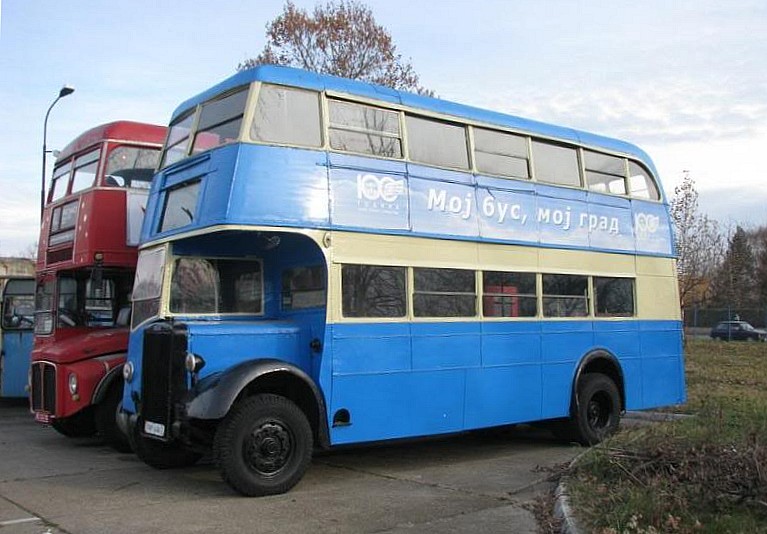
Some of you probably already know this, but I had forgotten and was reminded of it by Marin Panin, who is one of the moderators of the excellent Autobusi.org website in Croatia. 176 Leyland STD buses were built for London Transport between 1937 and 1946. The 90 pre-war examples were Titan TD4s with Leyland bodies, 11 'unfrozen' wartime deliveries were Titan TD7 with Park Royal bodies, and the post-war batch of 65 were Titan PD1s with Leyland bodies. Only one survives, and this is it.
All the pre-war and wartime examples were scrapped, but the whole post-war batch was exported to Yugoslavia in the mid 1950s. The sole survivor - STD171 (HLW 100), originally a Croydon-based bus dating from 1946 - has been preserved by GSP, bus operator in Novi Sad, Serbia. It now has offside front and rear entrance doors, has lost its original engine, and the interior is in a poor state. Wouldn't it be nice to have this back in the UK? However I understand that GSP don't want to part with it, which makes it surprising that they don't take a bit more care of it.
Many grateful thanks to Portos of the Autobusi.org website for the picture, taken in 2012. You can see more of his images here.
WEST YORKSHIRE LODEKKA IN GOOD SHAPE
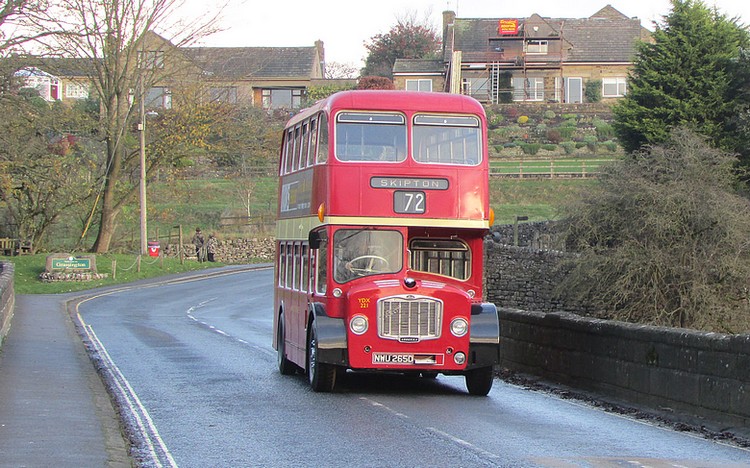
Keith Renshaw kindly sent me some information and pictures of West Yorkshire 1966 FS6B Lodekka YDX 221 (NWU 265D) which he operates with Simon Wood. Originally with a Bristol engine but now with a Gardner 6LW, it entered service in December 1966, allocated to the York West Yorkshire Joint Committee fleet and thus had a Y-prefix to its original fleet number. In the 1971 renumbering scheme it became 3821, the '3' indicating the York fleet in which it served continuously until being withdrawn in November 1980, by which time it was one of the last two Lodekkas in the fleet.
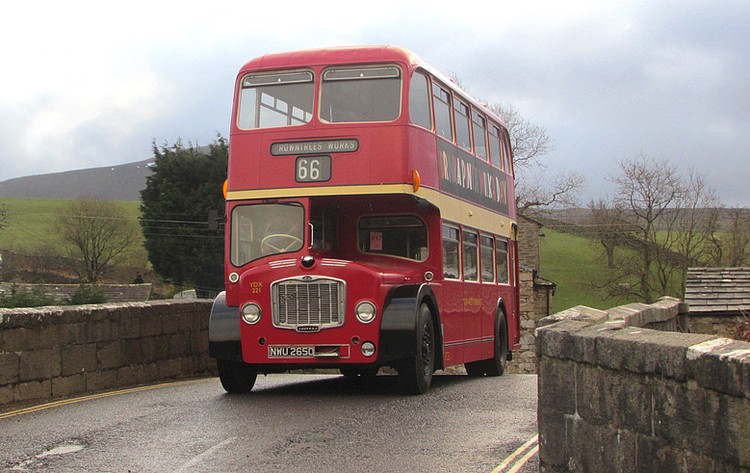
For the next 5 years it was a regular attendee on the rally circuit, but was later sold to a driving school. By 1990 it was in a yard in Crossflatts, near Keighley, and in danger of being scrapped. Preservationists then acquired it for £1400 but it was sold again in 1991, and then again in 1994 when a group rescued it and brought it to Keighley Bus Museum. Finally Keith Renshaw and Simon Wood (who took the photos) took over the vehicle from 2001 and are responsible for the current fine condition and preservation in its home county of West Yorkshire, despite it being 50 years old in 2016! Thanks very much to both of them for the words and pictures.
A MEMORIAL TO CHARLES HENRY ROE
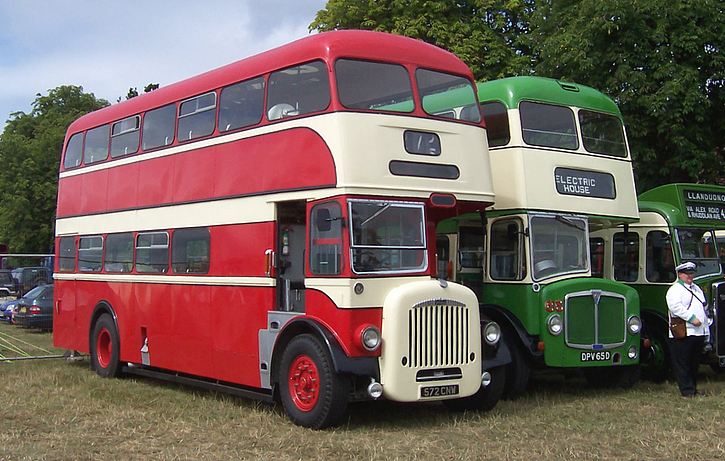
This picture of 1962 Roe-bodied Daimler CVG6 572 CNW (formerly Leeds No.572) seen by me at Taunton in 2006 is to draw your attention to an online petition set up by the Transport Yorkshire Preservation Group. Charles H Roe's Cross Gates factory in Leeds finally closed in 2011 when Optare moved elsewhere, and the building was demolished a year later. Now TYPG would like a small memorial (maybe a blue plaque or similar) to the man himself and the legacy he created, ideally on or near the former works.
As there is no other recognition of Mr C. H. Roe locally, the Group would like to petition Avant Homes, Leeds Civic Trust and Leeds City Council to allow the creation of a memorial to him in Cross Gates. You can add your name to the petition by clicking here.
P.S. Bob Wingrove says that's him lurking on the right. No time for lurking, Bob - get back on the bus!
See more archived news and pictures on Page 2 (older) or Page 3 (older still).
Want to see some more? Have a look at all the other profiles on the Classic Buses menu page.
SOME LINKS WITHIN THIS WEBSITE: Home Email Links THE COMPLETE WEBSITE MENU Events Diary Halfcab list Small-Ads Classic Irish Buses Classic Manx Buses